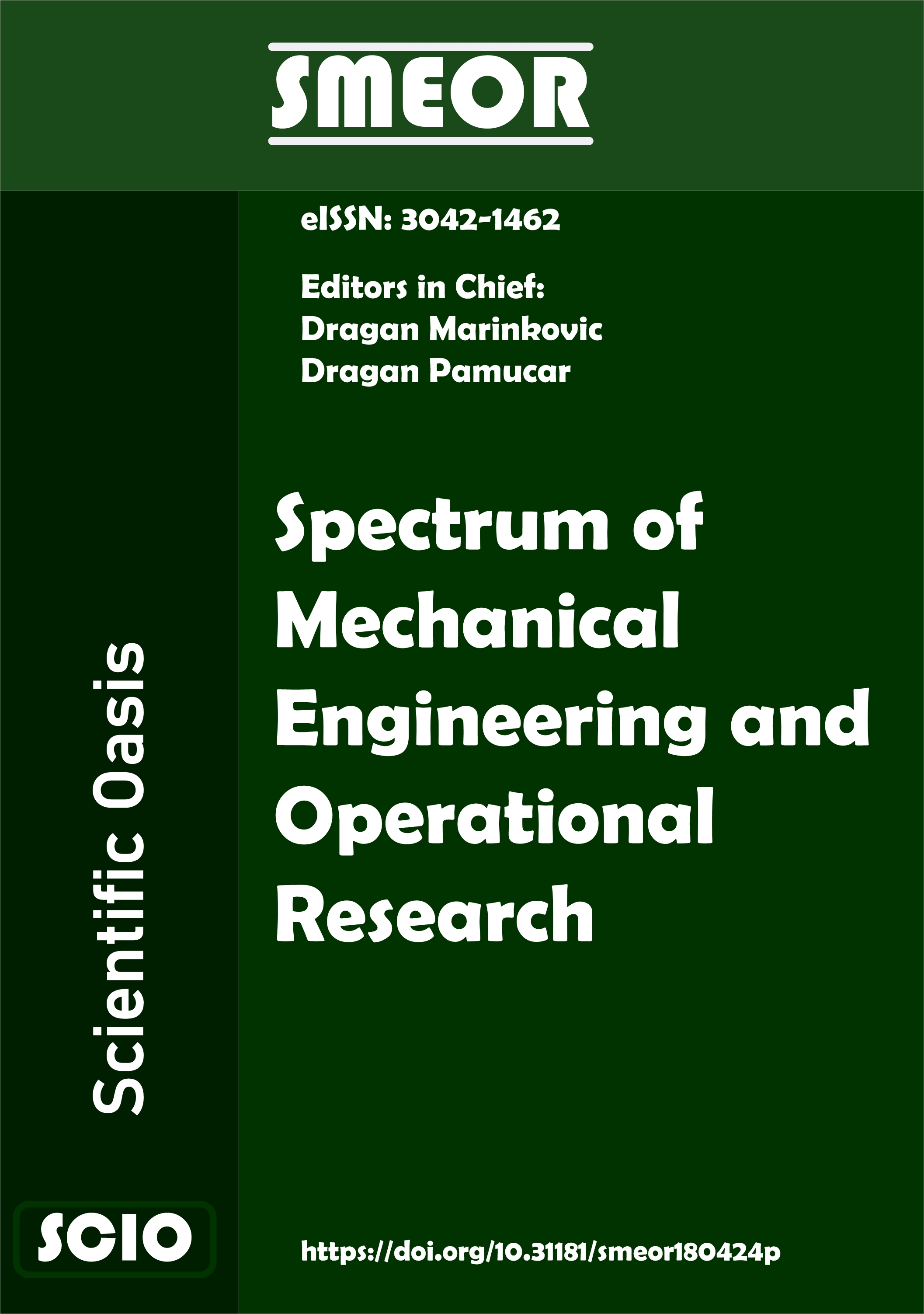A Simple Approximation for Indentation of Finite Elastic Layers by Parabolic, Conical, and Flat-ended Cylindrical Indenters
DOI:
https://doi.org/10.31181/smeor202650Keywords:
Elastic layer, Indentation, Method of dimensionality reductionAbstract
In this work, we develop simple approximation formulas for the indentation of compressible elastic layers of arbitrary thickness by parabolic, conical, and flat-ended cylindrical indenters. Most surprisingly, a compact “Pythagoras-like” interpolation between the half-space and thin-layer limits provides an excellent solution to the problem. The proposed empirical expressions are validated against extensive Boundary Element Method simulations, showing remarkable accuracy across a wide range of elastic moduli, Poisson’s ratios (up to 1/3), indenter geometries, penetration depths, and layer thicknesses. The approach is further extended to adhesive contacts of flat-ended punches, yielding compact estimates of adhesion forces in layered systems. Owing to their simplicity and robustness, the presented formulas provide practical correction rules for interpreting experimental indentation data, particularly in nanoindentation and atomic force microscopy of thin films and biological materials.
Downloads
References
Hayes, W. C., Keer, L. M., Herrmann, G., & Mockros, L. F. (1972). A mathematical analysis for indentation tests of articular cartilage. Journal of Biomechanics, 5(5), 541–551. https://doi.org/10.1016/0021-9290(72)90010-3
Jaffar, M. J. (2002). Frictionless contact between an elastic layer on a rigid base and a circular flat-ended punch with rounded edge or a conical punch with rounded tip. International Journal of Mechanical Sciences, 44(3), 545–560. https://doi.org/10.1016/S0020-7403(01)00087-1
Chadwick, R. S. (2002). Axisymmetric indentation of a thin incompressible elastic layer. SIAM Journal on Applied Mathematics, 62(5), 1520–1530. https://doi.org/10.1137/S003613990138822
Hensel, R., McMeeking, R. M., & Kossa, A. (2019). Adhesion of a rigid punch to a confined elastic layer revisited. The Journal of Adhesion, 95(1), 44–63. https://doi.org/10.1080/00218464.2017.1381603
Hermanowicz, P. (2021). Determination of Young’s modulus of samples of arbitrary thickness from force distance curves: Numerical investigations and simple approximate formulae. International Journal of Mechanical Sciences, 193, 106138. https://doi.org/10.1016/j.ijmecsci.2020.106138
Aleksandrov, V. M. (2003). Asymptotic solution of the axisymmetric contact problem for an elastic layer of incompressible material. Journal of Applied Mathematics and Mechanics, 67(4), 589–593. https://doi.org/10.1016/S0021-8928(03)90061-X
Gavara, N., & Chadwick, R. (2012). Determination of the elastic moduli of thin samples and adherent cells using conical atomic force microscope tips. Nature Nanotechnology, 7, 733–736. https://doi.org/10.1038/nnano.2012.163
Argatov, I., & Mishuris, G. (2018). Indentation testing of biological materials. Springer. https://doi.org/10.1007/978-3-319-78533-2
Argatov, I., Jin, X., & Mishuris, G. (2024). AFM-based adhesive indentation of polymer brushes: A phenomenological approach. International Journal of Adhesion and Adhesives, 128, 103555. https://doi.org/10.1016/j.ijadhadh.2023.103555
Argatov, I., Borodich, F. M., & Jin, X. (2022). Atomic Force Microscopy of polymer brushes: Insights into controversies. Frontiers in Mechanical Engineering, 8, 931271. https://doi.org/10.3389/fmech.2022.931271
Forsbach, F. (2023). A simple semi-analytical method for solving axisymmetric contact problems involving bonded and unbonded layers of arbitrary thickness. Machines, 11(4), 902. https://doi.org/10.3390/machines11040474
Argatov, I., Heß, M., & Popov, V. L. (2018). The extension of the method of dimensionality reduction to layered elastic media. ZAMM – Journal of Applied Mathematics and Mechanics, 98(4), 634–641. https://doi.org/10.1002/zamm.201700213
Argatov, I., & Popov, V. L. (2023). An adhesive detachment paradox: Does the substrate thickness matter? Mechanics Research Communications, 129, 104093. https://doi.org/10.1016/j.mechrescom.2023.104093
Li, Q., & Popov, V. L. (2019). Adhesive contact between a rigid body of arbitrary shape and a thin elastic coating. Acta Mechanica, 230, 1–7. https://doi.org/10.1007/s00707-019-02411-5
Lyashenko, I. A., Popov, V. L., & Borysiuk, V. (2023). Experimental verification of the boundary element method for adhesive contacts of a coated elastic half-space. Lubricants, 11(2), 84. https://doi.org/10.3390/lubricants11020084
Hertz, H. (1882). Über die Berührung fester elastischer Körper. Journal für die reine und angewandte Mathematik, 92, 156–171. https://doi.org/10.1515/crll.1882.92.156
Johnson, K. L. (1985). Contact mechanics. Cambridge University Press.
Popov, V. L. (2017). Contact mechanics and friction. Physical principles and application (2nd ed.). Springer. https://doi.org/10.1007/978-3-662-53081-8
Li, Q., Pohrt, R., Lyashenko, I. A., & Popov, V. L. (2020). Boundary element method for non-adhesive and adhesive contacts of a coated elastic half-space. Proceedings of the Institution of Mechanical Engineers, Part J: Journal of Engineering Tribology, 234(2), 226–234. https://doi.org/10.1177/1350650119875280
Love, A. E. H. (1939). Boussinesq’s problem for a rigid cone. The Quarterly Journal of Mathematics, 10(1), 161–175. https://doi.org/10.1093/qmath/os-10.1.161
Popov, V. L., Heß, M., & Willert, E. (2019). Handbook of contact mechanics: Exact solutions of axisymmetric contact problems. Springer. https://doi.org/10.1007/978-3-662-58709-6
Popov, V. L. (2018). Solution of adhesive contact problem on the basis of the known solution for non-adhesive one. Facta Universitatis, Series: Mechanical Engineering, 16(1), 93–98. https://doi.org/10.22190/FUME180105009P
Popov, V. L., Li, Q., & Willert, E. (2024). Approximate contact solutions for non-axisymmetric homogeneous and power-law graded elastic bodies: A practical tool for design engineers and tribologists. Friction, 12(2), 340–355. https://doi.org/10.1007/s40544-023-0780-5
Leroy, J.-E., & Popov, V. L. (2025). Boundary element simulation of the normal contact problem with a poroelastic half-space. *ZAMM‐Journal of Applied Mathematics and Mechanics/Zeitschrift für Angewandte Mathematik und Mechanik, 105*. https://doi.org/10.1002/zamm.70005
Poliakov, A., & Pakhaliuk, V. (2023). In silico analysis of an articular cartilage regenerative rehabilitation under conditions of mesenchymal cells implantation and their mechanical stimulation. Facta Universitatis, Series: Mechanical Engineering, 22(3), 399–422. https://doi.org/10.22190/FUME230919051P
Downloads
Published
Issue
Section
License
Copyright (c) 2025 Valentin L. Popov, Mikhail Popov, Iakov A. Lyashenko (Author)

This work is licensed under a Creative Commons Attribution 4.0 International License.



















 All site content, except where otherwise noted, is licensed under the
All site content, except where otherwise noted, is licensed under the 